 Fall Sere
Fall Sere
Autumn has arrived. With the hounds of winter presumably on its traces.
The leaves have now mostly turned and dropped, always lovely to watch yet also somehow melancholic. So, while enjoying the seasonal spectacular, we turned our attention to the coming winter, and our preparations for it.
Timber!
Atop the fall task list: extensive tree removal. We had a baker’s dozen old-growth trees — mostly live, but a few dead — overhanging or in dangerous proximity to the lane, the power lines, and the house and outbuildings. Never pruned or shaped by the previous owners, they’d become spindly and ungainly. And dangerous. Numerous other large trees in good health on the property will stay — a pair of magnificent pines, a towering oak and maple — but the time has come for these to go.
This cost a bundle, but proved worth it. Safety aside, it has several benefits. Taking these down opens up the space visually and lets it breathe; what felt cramped and crowded suddenly expands. We’ll also keep the wood and eventually use it: some in the fireplace (more on that below), some for repurposing into fencing and raised beds and other features, some possibly for sale (we have some oak and maple). So over time this one-time job will pay for itself, at least in part.
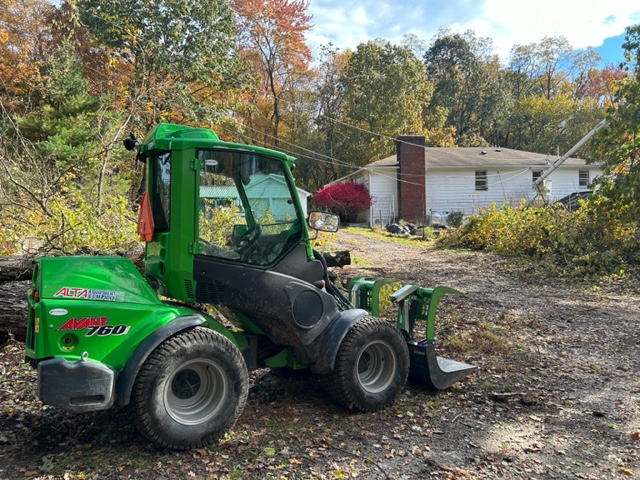
Tree work on our property, October 2023
•
The Roof Always Leaks
Years ago I offered that bit of hard-earned homeowner wisdom to my friend Julio Mitchel, who commemorated it in a graphic that hangs on my office wall. (As this photo suggests, it proved prophetic; the old roof of the new house leaked on it.)
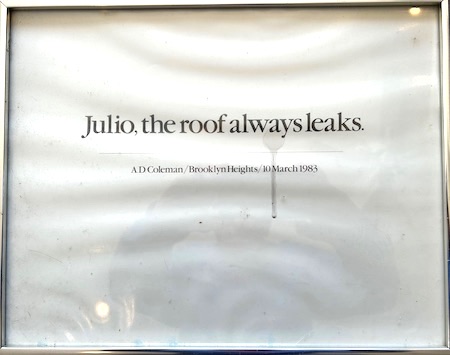
The roof always leaks. Graphic by Julio Mitchel, 1983.
•
I’d add a footnote to it, which is that if it’s not actually leaking it’s preparing to leak. Except for what we might think of as the honeymoon period, when you have put a brand-new roof in place. Which we have just done (costing us another, bigger bundle).
Our house, built circa 1962, still had its original half-inch plywood sheathing, with only a layer of roofers’ felt between that and the original asphalt shingles. And it was leaking in several places. So we had our contractor strip off the entire original roof, plywood and all. Then they re-sheathed it in 3/4-inch CDX plywood, topped with a water barrier, topped with new felt, and then new top-of-the-line shingles — an integrated GAF system. Improved venting included. As part of the job they also re-shingled our garage.
This job, done in two installments with the re-roofing in between, got done in two days, start to finish, including a thorough clean-up. (After they left, and the dumpster got hauled away, we swept up a mere half a trash bag’s debris.) The crew — all Latino/Chicano — worked like the proverbial well-oiled machine; it was a pleasure to watch them.
Installed by a GAF-trained and certified team, this roofing system comes with a 50-year warranty, so we should never have to worry about it again. Perhaps the roof doesn’t and won’t always leak, my pragmatic counsel to Julio notwithstanding.
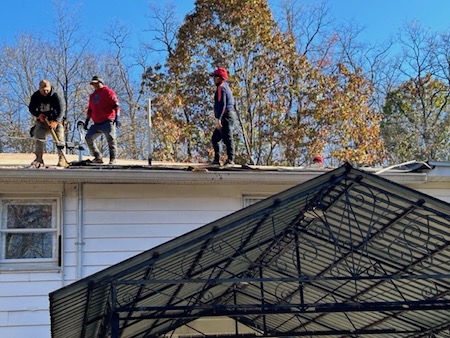
Our roofers at work, November 2023.
•
Replacing the roof makes us eligible for new attic insulation, subsidized by a New York State weatherization program. That should happen this month or next. We don’t plan any further major renovations of the house in the foreseeable future.
Le Corbusier defined a house as “a machine for living.” Having put our machine through some major upgrades, we will now take it out for a metaphorical spin.
•
Baby, It’s Cold Outside
For reasons undisclosed, this house has two heating systems: the north half runs on propane, using a Prestige boiler that supplies baseboard hot water to its single level and also on-demand household hot water for the whole house. The south end’s baseboard system gets its hot water from a Peerless cast-iron oil burner that heats its two levels. Three thermostats for different zones.
Both boilers are top of the line, recently serviced and in excellent condition. Between them they do a good job, but both propane and oil don’t come cheap. We pre-bought our year’s supply in August, for a total somewhere around $5K.
•
As indicated above, we have an ample supply of free firewood. During the cold season 2022-23 we used the living-room fireplace often, but found it inefficient as a heat source — its main effect was symbolic and psychological. In September it got its first-ever cleaning by a sweep, who installed a top-mounted damper to keep cold air from blowing in when it’s not in use.
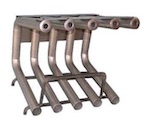 I also invested $700 in a passive heat-recycling grate that promises to pump heated air out into the room instead of up the chimney. I have my fingers crossed. If it works, it’ll reduce our fuel usage and eventually recoup its cost.
I also invested $700 in a passive heat-recycling grate that promises to pump heated air out into the room instead of up the chimney. I have my fingers crossed. If it works, it’ll reduce our fuel usage and eventually recoup its cost.
The original owner had the fireplace built very well, but without permit from the town. That made it technically illegal, which meant that if anything happened as a result of its use our insurance might not have covered it. So I scheduled an inspection, to get it grandfathered in by the building department, after which I registered it with our insurers. Can’t be too careful. Shortly Jacky will apply a masonry sealer to the entire exterior of the chimney, to keep moisture from seeping into the bricks and deteriorating them.
•
The weather here continues erratic. Summer proved often overcast, also steadily wet and hot, with the added aggravation of smoke from Canadian fires. Sometimes so hot and humid that my brain didn’t function. We have ceiling fans in all rooms, plus some window models and portable ones, and those sufficed for basic comfort. (We also have a pair of portable air conditioners, for heat-wave emergencies, but didn’t feel the need to use them.)
So far this autumn we’re getting a comparatively normal mix of rain, overcast chilliness, and warmish sunny days. Until the beginning of November the indoor temperature didn’t often drop low enough in the daytime to trigger the boilers, so we needed to dress more warmly — Anna and I both pulled on long johns, an infallible sign that we have started heading toward winter in our minds and bodies.
Up until now, parts of the house have stayed uncomfortably cool, even cold, in winter. We’ve consulted with several contractors about heat pumps. The high-end geothermal models, which draw heat from the earth, simply cost way too much. They also don’t fit well with our house, which does not have central heating. Attic-mounted versions, also pricey, don’t appeal to us. Mini-splits — stand-alone wall-mounted units that provide heat in winter and cooling in summer — would solve the problem, but the best ones don’t come cheap ($6K each including installation).
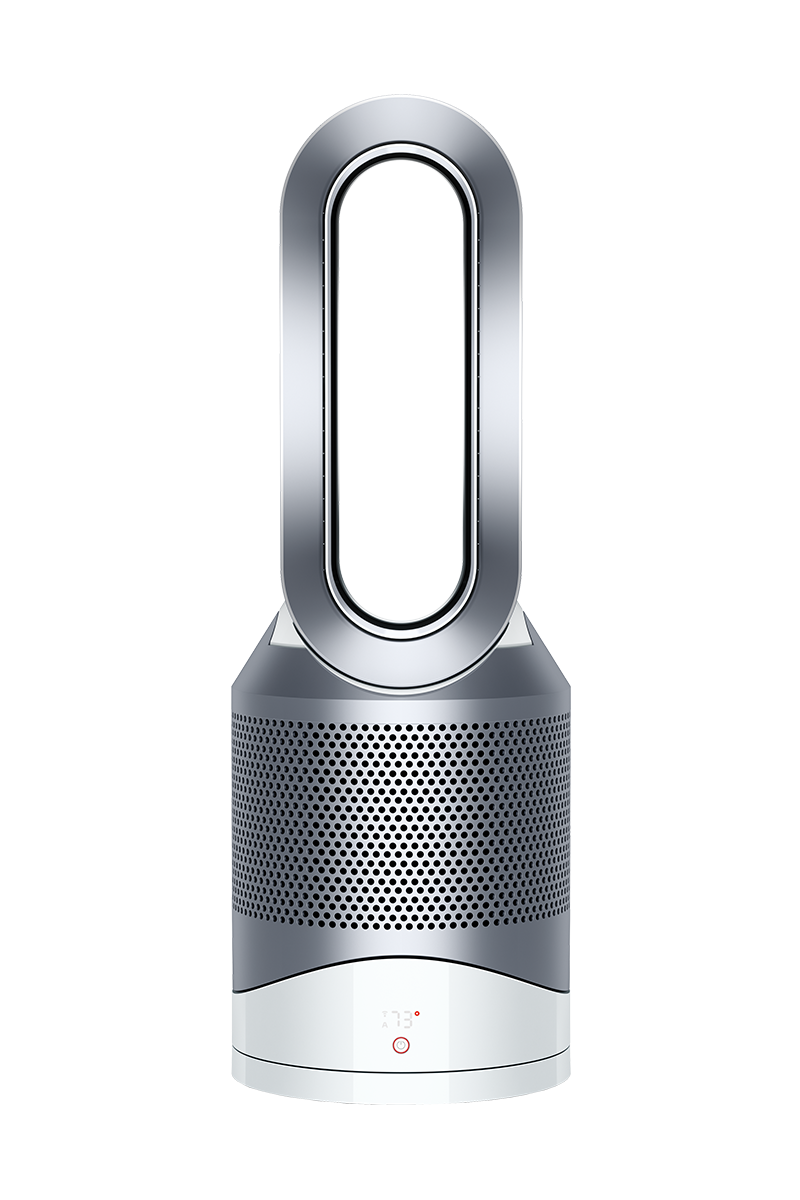
Dyson Pure Hot+Cool™ purifier fan heater
So we’ll ride out the heating season with our system as it is now, and see how that works out. I bought a refurbished high-end Dyson Pure Hot+Cool™ purifier fan heater for the office, dependably the coldest room in the house. It stands hip-high, has something akin to an R2D2 look, comes with a remote and an app — which makes it by far the smartest device in the house. If it can keep the office toasty on the coldest days, it will solve that problem at a fraction of the cost of a mini-split.
•
We have four new thermal windows already on site for replacement of original windows on the north end, as soon as we find someone competent to handle that job. And we’ve newly weather-stripped our front door. All of which should reduce heat loss and increase the coziness factor. Our ceiling fans will also help.
Additionally, we now have a new second refrigerator, to replace a decrepit old one. And we’ve begun installation of a heavy-duty vent fan — specifically designed for Chinese-style cooking — for the electric stove in the main kitchen.
•
Harvest Report
Anna has prepped the garden for winter. Our haul for the year: Two red-currant bushes and three blueberry bushes planted in spring 2021 gave us fruit again this year. Two peach trees planted at the same time also fruited, these for the first time. (We got 21 pounds of peaches from the pair, which, at $4.99 lb. in our local market, almost completely pays for the $120 cost of the trees themselves.) Two grapevines also planted then started to fruit — too soon to tell if their output is edible. Strawberry plants started in spring 2022 survived the winter and fruited, amply.
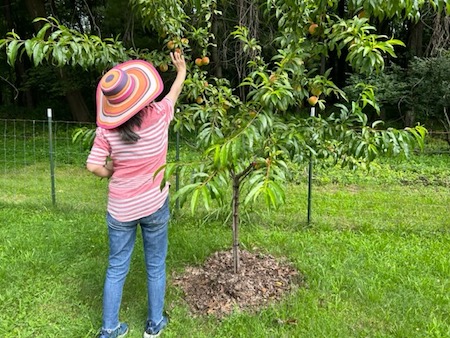
Anna picking peaches, July 24, 2023
•
Three young fig trees that we transplanted from Staten Island have survived, put down roots, and sent up new growth. They won’t fruit until next year at the earliest.
We put in a full vegetable garden this spring — varied tomatoes, Japanese eggplant, bitter melon, snow peas, a number of other things. Plus some herbs: basil, sage mint. Of the veggies, only the tomatoes did well, but only modestly so compared to the bumper crops we got on Staten Island. Not a total loss — nothing compares to home-grown tomatoes — but nothing to write home about either.
We ascribe that mostly to the quality of the dirt. I’d mulched and composted the soil in the Staten Island garden for decades, adding in some manure and peat moss each year. When Anna arrived in New York she started digging in fall leaves that the neighbors bagged and set out for collection. Over time, that made the originally dense, clay-like soil into fertile earth for planting.
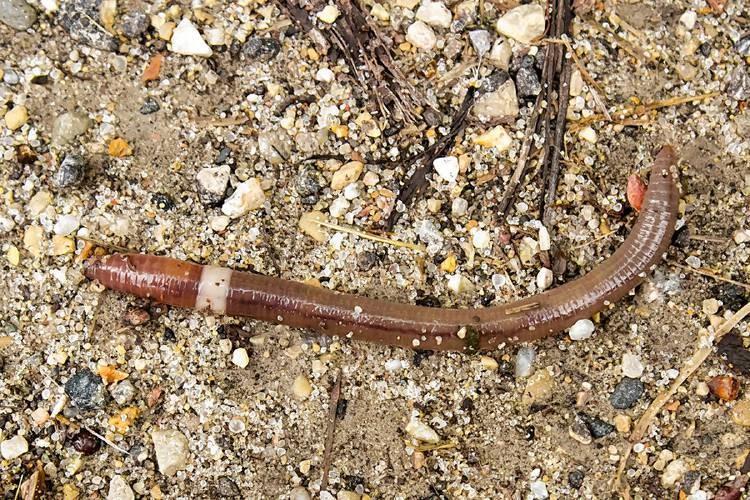
Jumping worm
The soil on our little acre here is similarly dense and clay-like as we start out — and also stony. So our veggie garden’s raised beds contain screened topsoil mixed with leaves from our surrounding trees plus a year’s worth of kitchen scraps for composting, which have had a relatively short time to break down and intermix. Not exactly the most nutritious support system for veggies and herbs.
Analysis of soil samples from the property indicates that generally its pH sits just slightly on the alkaline side, somewhere between 6.0 and 7.0. We also discovered that we have an abundance of jumping worms, an invasive species about which we knew nothing until now. Among their effects:
- They “rapidly deplete topsoil of all nutrients” (which is bad).
- They aerate the soil (which is good), but so thoroughly that new plants can’t root (which is bad).
- Their castings add to the alkalinity of the soil in which they live.
- They attract moles, which feed on them (among numerous other forms of sustenance).
According to the experts, the only way to control them involves putting any we find into plastic bags, cooking them in the sun on the driveway, and throwing them into the trash. Given the frequency with which they show up wherever we dig, this strikes us as pissing in the wind.
Apparently we also have colonies of moles and voles (the latter a/k/a field mice), both of which benefit us by building tunnels — thus also aerating the soil — while simultaneously rendering the surface uneven and spongy (undesirable). Fortunately, they did not get at our fruits and vegetables.
On principle, we have decided against any chemical pesticides, traps, or other non-organic deterrents for these critters beyond some sonar devices positioned around the growing areas. This is their world, after all; we just live in it, and will find ways of accommodating ourselves to the existing ecology and/or adjusting it in holistic fashion.
Between the poor-quality dirt, the past growing season’s excess water, the paucity of direct sunlight, and the jumping worms, we don’t find it surprising that the garden didn’t thrive this past summer. Cutting down some of the trees will increase the sunlight. Judicious application of pine needles (of which we have an abundance) and vinegar can remediate the alkalinity of the soil. We have a supply of leaves bagged for use in the spring. We have leaf mold available in the surrounding woods for composting. We can probably find a local source of manure. So next year’s soil will improve on this year’s, and so on.
Did last summer’s atmospheric condition constitute a new normal here? There’s nothing we can do about overcast skies and wet weather. Or the jumping worms. Which has us thinking about building a greenhouse …






•
This post sponsored by a donation from Carlyle T.
•
Special offer: If you want me to either continue pursuing a particular subject or give you a break and (for one post) write on a topic — my choice — other than the current main story, make a donation of $50 via the PayPal widget below, indicating your preference in a note accompanying your donation. I’ll credit you as that new post’s sponsor, and link to a website of your choosing.
And, as a bonus, I’ll send you a signed copy of my new book, poetic license / poetic justice — published under my full name, Allan Douglass Coleman, which I use for my creative writing.